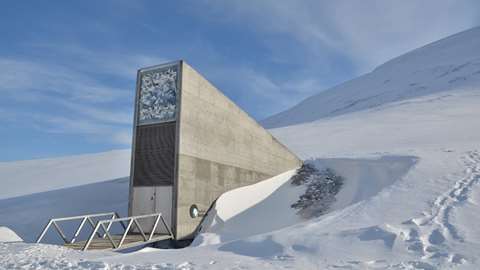FAO: Save the seeds and the living plants
 Svalbard seed vault is the apex of a global network to protecting plant genetic resources for food and agriculture, storing the seeds of vital crops in an underground vault near Svalbard, Norway, will celebrate its 10th anniversary soon, drawing deserved attention to the importance of conserving seeds that are vital for food and agriculture.
Svalbard seed vault is the apex of a global network to protecting plant genetic resources for food and agriculture, storing the seeds of vital crops in an underground vault near Svalbard, Norway, will celebrate its 10th anniversary soon, drawing deserved attention to the importance of conserving seeds that are vital for food and agriculture.
It was the adoption of the International Treaty on Plant Genetic Resources for Food and Agriculture in 2001 that gave the impetus to the Norwegian government to proceed with the establishment of the Seed Vault; the Commission on Genetic Resources for Food and Agriculture welcomed and supported the initiative in 2004.
The resources and attention given to Svalbard, now the iconic home to seeds of around one million unique plants, is welcome. While farmers have bred crops for millennia, the emphasis on conservation of crop diversity ex situ is historically linked to Nikolai Vavilov, who set up one of the first genebanks in Russia in 1921. In a quest to end all famines, the botanist travelled to more than 60 countries, listening to farmers and collecting seeds with an eye to their potential to contribute to hardier crops in a changing world.
Accessions from genebanks that were subsequently established have been used to breed crop varieties that are better suited for food production, such as those that proved resistant to the rust diseases that can decimate wheat and maize harvests, and to produce rice varieties able to withstand salty soils, inject new resilience in highly-domesticated crops and contribute to innovations that changing climate conditions may require, such as faster maturation or drought tolerance.
Into the wild
While focus on conservation in genebanks is necessary, many of the genetic resources needed to underwrite sustainable food systems are found on-farm in the form of farmers' varieties and landraces and also in nature as crop wild relatives.
Consider the sunflower, a native to North America, where samples of 53 species of sunflower wild relatives have been collected and stored. Varieties with elevated oil contents were developed in Russia, followed by significant improvements driven by a French scientist who tapped genetic quirks in a wild prairie sunflower, and today the crop is grown in more than 70 countries and accounts for an annual revenue of $20 billion.
Wild plants, notably those related to edible mainstays, are increasingly under threat and warrant increased efforts for their conservation and utilization. These plants are rarely part of intense crop improvement programmes. Yet experts know they often provide interesting traits that can work wonders on crops.
That's why researchers scour central Asia in search of apple varieties, Papua New Guinea for sugar cane, and are excited to have found a wild banana in Southeast Asia that may help propagate resistance to a deadly fungus that is decimating the popular Cavendish variety.
Recently researchers have discovered previously unknown information on the genetic history of the wild relatives of cultivated chickpea, offering promising potential for a popular pulse food for which improvement has been hampered by an extreme lack of genetic diversity.
Many locally important food crops grow in parts of the world facing rapid change and high levels of food insecurity. To help countries in the daunting task of protecting the species relevant to their food supply in their natural habitats where they would continue to evolve important traits for adaptation to changes, FAO recently published Voluntary Guidelines for the Conservation and Sustainable Use of Crop Wild Relatives and Wild Food Plants.
"Crop wild relatives have saved our skins many times and may become stars in our climate change toolkit," says Chikelu Mba, a plant geneticist and Leader of the Seeds and Genetic Resources team at FAO.
Setting up protected areas is a key step. "Many countries in fact have them, and there is a potential to combine CWR conservation with nature conservation" notes Mba. "But few know what is inside them."
Overcome extinction threats
Conservation efforts need to be accelerated now as climate change, urbanization and shifting land-use patterns all pose increasingly imminent threats to the survival of many of these relatively unsung species.
"The diversity of both crop wild relatives and wild food plants are being continuously eroded and many could become extinct if the current level of neglect is not checked," says Ren Wang, FAO Assistant Director-General, Agriculture and Consumer Protection Department.
Wild crop relatives tend to be most diverse and prolific in a food crop's ancestral center of origin - the potato in the Andes, sugarcane in Asia - and also in secondary diversity zones such as the Mediterranean for the tomato and sub-Saharan Africa for cassava. That, one of Vavilov's pioneering insights, helps in choosing appropriate locations for conservation areas.
Source: FAO

